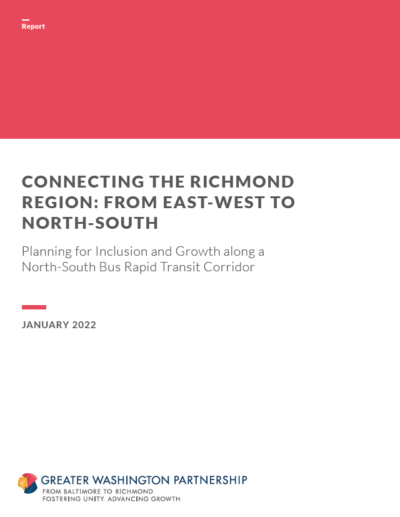Connecting the Richmond Region: From East-West to North-South
Publish Date: January 2022

 Download Report »
Download Report »
Richmond, Chesterfield, and Henrico – the most populous jurisdictions in the Richmond metropolitan area – are already planning for a more transit-oriented future. This report builds upon their work by offering a regional strategy to collaboratively expand the award-winning Pulse Bus Rapid Transit (BRT) network and to proactively create a more inclusive, vibrant, and healthy region.
Richmond, Chesterfield, and Henrico – the most populous jurisdictions in the Richmond metropolitan area – are already planning for a more transit-oriented future. This report builds upon their work by offering a regional strategy to collaboratively expand the award-winning Pulse Bus Rapid Transit (BRT) network and to proactively create a more inclusive, vibrant, and healthy region.
Investing in public transportation drives economic and social growth by providing more sustainable and more inclusive connections to job opportunities and to each other. Between the launch of the world’s first trolley line in 1888 and the dismantling of the streetcar system in 1949, the City of Richmond’s population grew from 80,000 to 230,000 residents. That growth was only possible because of the vibrant communities that grew along the streetcar lines. In the second half of the 20th century, the region’s population growth followed new car-oriented transportation investments to the suburbs, where new communities flourished in Chesterfield and Henrico Counties.
Communities that grew along streetcar lines were designed to be walkable to nearby job and commercial opportunities, whereas communities built further afield were often only accessible by car. As jobs followed residents to the suburbs, families without a car, and even families with only one car, were increasingly limited in their access to opportunities. While the automobile unlocked unprecedented growth, it generated equally significant challenges, including roadway congestion, vehicle exhaust and pollution, greenhouse gases, roadway fatalities, urban sprawl, and deepening racial and economic segregation. Today, more than 25,000 households across the City of Richmond, Chesterfield, and Henrico Counties do not own a vehicle.
This report was designed to build upon previous work by examining the socio-economic changes and potential benefits that could result from the expansion of the regional BRT network. Working with GRTC, the Virginia Department of Rail and Public Transportation, Plan RVA, ChamberRVA, and the Richmond Association of Realtors, an advisory committee of regional stakeholders, along with technical support from EY, this report uses the goals of the Pulse Corridor Plan to summarize and assess data on the early impacts from the East-West Pulse Corridor and expected impacts along a preferred North-South Pulse BRT alignment.